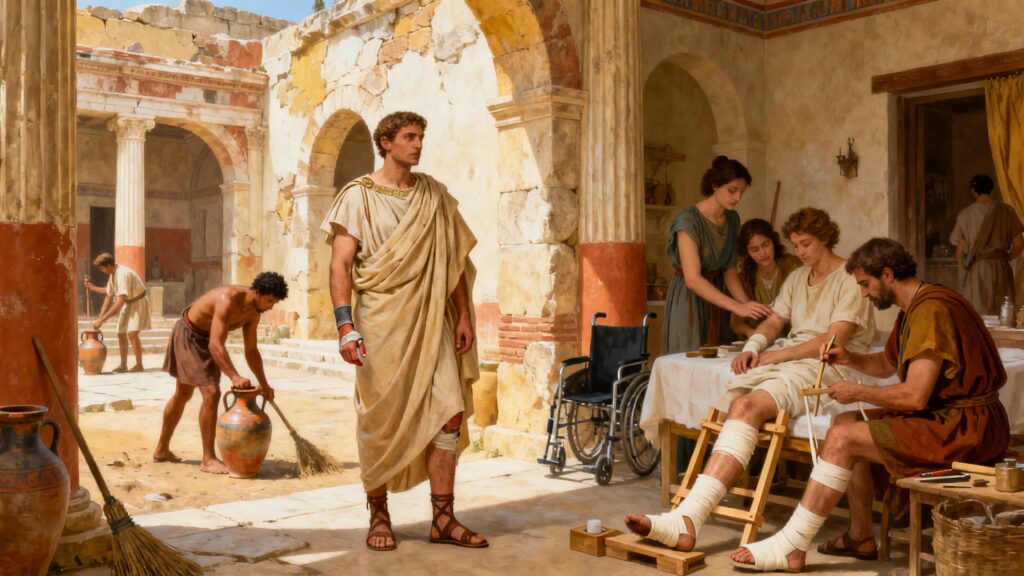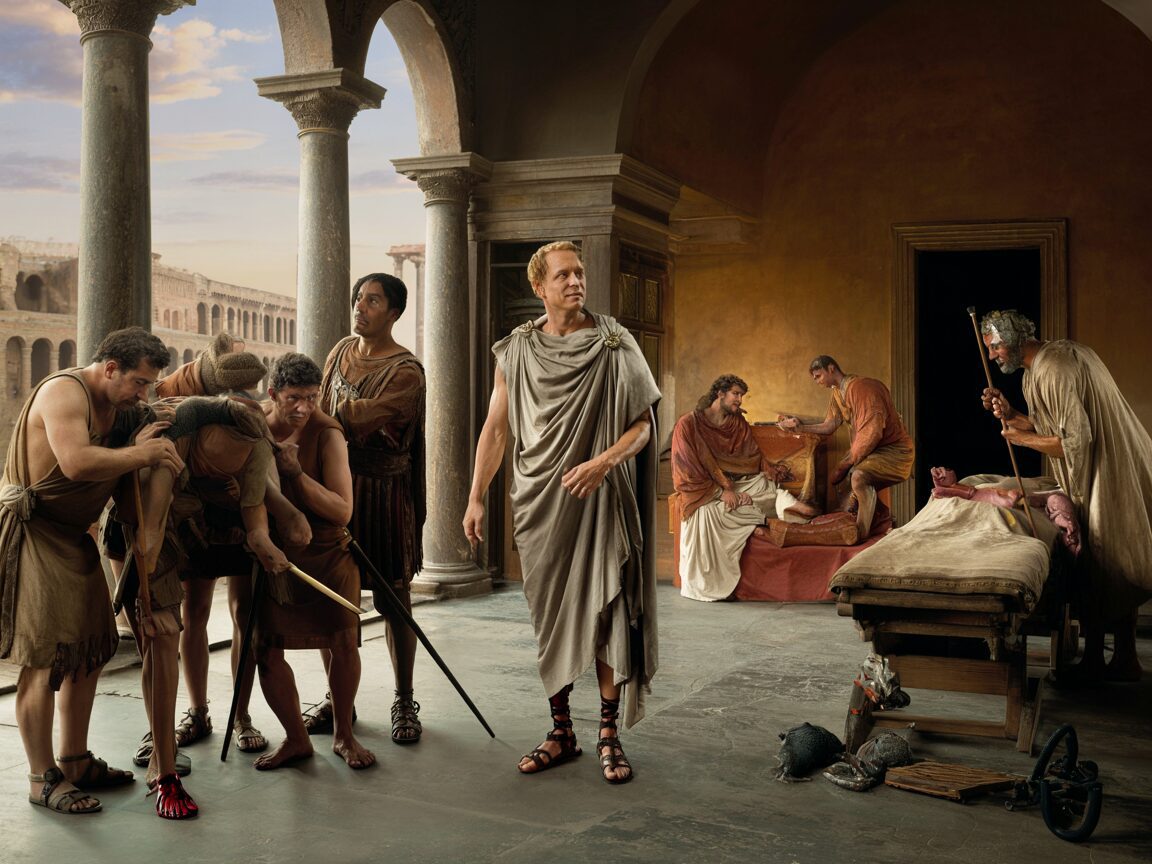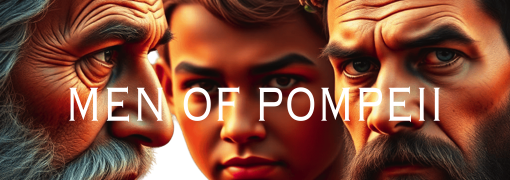How did Romans view disability? Exploring social attitudes toward physical difference in antiquity reveals a complex picture shaped by cultural, legal, religious, and medical factors. Roman society inherited Greek ideals linking physical wholeness to excellence but adapted these into their own pragmatic frameworks. Disability was not simply a personal condition but a social category with varied implications.
This article examines:
- Cultural perceptions of disability shaped by philosophy and societal ideals
- Legal classifications that defined rights and capacities of disabled individuals
- The role of social status, family dynamics, and occupation in shaping experiences
- How religious beliefs and medical practices influenced attitudes toward physical difference
Understanding how disabilities were perceived in ancient Rome provides valuable insights into the cultural complexities surrounding physical differences. It sheds light on how such perceptions impacted the lives and societal roles of individuals with disabilities, revealing attitudes that went beyond mere stigma or exclusion.
The cultural perceptions were often reflected in the art and propaganda of the time. For instance, Roman sculpture evolved significantly over time, showcasing a distinct focus on realism and the portrayal of power. These sculptures served not only as artistic expressions but also as instruments for political propaganda and religious devotion. Similarly, coins were used as powerful tools by emperors to convey their authority and legitimacy, becoming significant instruments for political messaging.
Cultural and Philosophical Foundations of Disability in Ancient Rome
Roman attitudes toward disability were greatly influenced by Greek culture, particularly its philosophical focus on physical perfection. Greek philosophers such as Plato and Aristotle advocated the belief that a complete physical form represented moral and intellectual superiority. The ideal human body symbolized not only beauty, as discussed in Plato’s writings on beauty, but also nobility and virtue, establishing a standard by which individuals were evaluated.
Roman Adaptation of Greek Ideals
The Romans embraced these ideals but modified them to suit their practical and social circumstances. Roman cultural values esteemed a strong, flawless body as a sign of power and competence—qualities crucial for military service, civic responsibilities, and leadership positions. This is especially significant when examining the force and strategy of the Roman military, which mirrored the empire itself—vast, diverse, and intricately organized. Physical disabilities were often seen as departures from this ideal, indicating weakness or inadequacy.
Key Points
- Physical perfection as a reflection of personal and social worth: A flawless body was equated with honor and status.
- Disability as a social stigma: Impairments contradicted the Roman preference for an idealized body free from visible defects.
- Cultural reinforcement through art and public life: Statues, coins, and public figures consistently showcased the ideal Roman physique.
The connection between nobility and beauty created a framework where individuals with disabilities encountered obstacles to their societal acceptance. This glorification molded the perception of disability—not simply as a bodily condition but as a factor influencing one’s position within Roman society.
Changes in Societal Ideals
However, it is essential to recognize that these societal ideals were not immune to transformation. The decline of the Western Roman Empire serves as a stark reminder of how political instability and weak leadership can undermine even the most powerful civilizations. As one of history’s mightiest empires, Rome’s downfall was not solely due to outside invasions but rather a complicated interaction of internal conflict and ineffective governance.

Legal Perspectives on Disability in Roman Society
Roman law had specific rules regarding disabilities, which had legal implications. The Romans made a distinction between capax (those who were legally competent) and incapax (those who were considered incapable), often based on physical and mental conditions. This classification affected various rights, including:
- Contractual capacity: Individuals recognized as legally impaired could be restricted from entering contracts or managing financial affairs independently.
- Property ownership: Disabilities could limit one’s ability to hold or inherit property without a guardian’s oversight.
- Guardianship: The legal system appointed guardians (tutores or curatores) for those considered incompetent due to disabilities, ensuring protection and management of their legal and economic interests. This practice is reminiscent of modern guardianship laws that still exist today.
The categories of impairment included mental incapacity, sensory deficits, and physical disabilities that affected decision-making or social functioning. Guardianship played both a protective and controlling role, reflecting societal concerns about vulnerability and trustworthiness.
Roman laws did not completely exclude disabled persons but imposed different restrictions based on perceived abilities. Legal competence was not solely determined by the presence of a disability but by its impact on civic duties and responsibilities. Disabled individuals with reduced competence were integrated into legal systems that aimed to balance protection with social order.
This legal perspective shows how Roman society defined disability—not just as a personal condition but as something that influenced a person’s public and private agency within the community. Such understanding of the lasting impact of Roman law reveals how ancient legal systems continue to influence modern ones worldwide. Additionally, comprehending the impact of Roman society on Western civilization provides insight into the societal structures that have developed from these ancient practices, affecting various aspects of present-day life.

Social Status and Disability: Class, Citizenship, and Occupation
Social status played a decisive role in shaping how disability was experienced and perceived in ancient Rome. The interaction between class, citizenship, and physical impairment created vastly different realities for disabled individuals.
The Reality of Elite Disabled Romans
Elite Disabled Romans often maintained a degree of social respect and legal privilege despite their impairments. Their status allowed access to patronage networks, political influence, and societal roles that could compensate for physical limitations. Disabilities might be downplayed or reframed as marks of perseverance or divine favor, especially if the individual retained their public duties or military command.
The Struggles of Enslaved Persons with Impairments
In stark contrast, enslaved persons with impairments faced extreme marginalization. Their lack of citizenship compounded the social stigma associated with disability. Seen as property rather than persons, their usefulness was primarily measured by physical labor capacity. An enslaved person with a disability was often deemed less valuable or discarded, reflecting harsh attitudes toward bodily difference within lower social strata.
The Influence of Citizenship on Disability Rights
Citizenship status influenced legal protections and rights related to disability. Citizens could invoke laws concerning guardianship or inheritance despite impairments, while non-citizens had limited recourse. This legal distinction reinforced social hierarchies where citizenship itself was a form of social capital buffering against exclusion due to disability.
Roman attitudes toward disability were thus inseparable from questions of class and political identity. Physical difference intersected with existing power structures, amplifying inequalities but also allowing some disabled individuals to navigate society with varying degrees of agency depending on their place within the social order.
Family Dynamics and Disability within the Roman Familia
The Roman familia was the basic social and economic unit of society. Disability was not just seen as something affecting one person, but also had an impact on how the household was managed and the roles of family members. In this context, physical differences influenced daily life and relationships, shaping how disabled family members were viewed and included.
Key aspects of Roman familia disability included:
- Role assignment: Disabled individuals often took on specific roles within the household. Some were caregivers or contributed according to their abilities, while others might have been viewed primarily as dependents requiring protection or assistance.
- Sources of shame or burden: Disabilities could be seen as a reflection of familial misfortune or divine disfavor, leading to feelings of shame that affected both the individual and the family’s social standing.
- Household management challenges: Physical impairments sometimes complicated tasks essential to running a familia, such as cultivating land, managing slaves, or conducting business. Families adapted by redistributing responsibilities among able members.
- Emotional and practical care: Evidence suggests that some disabled family members received care within the home rather than being excluded, indicating a complex balance between acceptance and marginalization.
Disability within Roman families was neither uniformly stigmatized nor fully embraced. The intersection between personal physical difference and collective family identity created a dynamic where roles adjusted based on necessity, social expectations, and the nature of impairment.
This complexity is further reflected in the masterpieces of Roman art, which serve as a testament to the empire’s vast reach and its ability to assimilate and innovate. Emerging from the confluence of various cultures, this artistic tradition spans several centuries and reflects not only the aesthetic values of its time but also the social, political, and cultural dynamics that shaped the Roman world.

Religious Beliefs and Interpretations of Disability in Ancient Rome
Religious attitudes toward disability in ancient Rome were deeply intertwined with the concept of divine punishment and spiritual impurity. Roman religion often viewed physical differences as signs that the gods were unhappy or that someone had broken sacred laws. This belief could lead to social exclusion, as disabilities were sometimes seen not just as personal problems but also as indications of moral or spiritual failure.
Responses to Disability in Ancient Rome
- Disabilities might be interpreted as omens or warnings from the divine, influencing how communities responded to those affected.
- Ritual purification and offerings to gods were common responses aimed at alleviating perceived spiritual contamination or appeasing divine anger.
However, Roman mythology presents alternative stories that challenge these interpretations. Figures such as Hephaestus, the god of fire and craftsmanship, disrupt simple connections between physical impairment and divine disapproval.
- Hephaestus was depicted with a physical deformity yet celebrated for his extraordinary skills and essential role among the gods.
- His story illustrates that disability did not always mean disgrace; sometimes it signified unique value or purpose within the mythological framework.
This complexity in religious beliefs shows a more nuanced understanding of disability—one that combined fear and stigma with recognition of exceptional ability and divine importance. The Roman Pantheon, with its diverse collection of gods and goddesses, further reflects the values, beliefs, and customs that influenced the lives of its people, including their views on disability.
Medical Understanding and Treatment Approaches Towards Disabilities in Antiquity
Roman Medical Thought and Disability
Roman medical understanding of disability was heavily influenced by humoral theory, a concept borrowed from Greek medicine. This theory proposed that the body’s health relied on the balance of four bodily fluids: blood, phlegm, black bile, and yellow bile. When someone had a disability, it was often seen as an imbalance or deficiency in these humors.
Physicians in ancient Rome aimed to restore this balance through various treatments such as:
- Regulating the patient’s diet
- Performing bloodletting procedures
- Using herbal remedies
This approach shaped how people viewed physical impairments—not just as conditions but as disruptions in the body’s natural harmony.
Surgical Interventions and Practical Responses
While surgical interventions did exist during Roman times, they were limited in scope and practicality. Roman surgeons primarily performed procedures to treat wounds sustained in battles or accidents rather than addressing congenital or chronic disabilities.
Prosthetics also emerged during this period, mainly for military veterans who had lost limbs. This demonstrates a practical response to disability that was closely tied to social status and utility within society.
Healing Cults and Holistic Perspectives
Healing cults played a significant role in how disabilities were treated and perceived in antiquity. Temples dedicated to Asclepius, the god of healing, attracted disabled individuals seeking both divine intervention and medical care.
These religious healing practices combined spiritual beliefs with physical treatment methods, reflecting a holistic view of disability during that time.

Early Christian Influences on Attitudes Toward Disability in Ancient Rome
Early Christianity introduced a transformative perspective on disability that contrasted sharply with traditional Roman views.
Marginalization vs. Inclusion
While Roman society often marginalized those with disabilities—excluding them from full civic participation due to perceived physical and social deficiencies—Christian teachings emphasized spiritual dimensions of suffering.
Key themes shaping early Christian attitudes included:
- Spiritual suffering as redemptive: Disabilities were seen as trials that could lead to moral and spiritual growth.
- Healing miracles: Accounts of Christ’s healing works highlighted the possibility of divine restoration beyond physical limitations.
- Inclusion within the community: Disabled individuals were embraced as full members of the Christian fellowship regardless of their bodily conditions.
This shift began to challenge earlier cultural assumptions that equated physical wholeness with moral or social value. By framing disability within a narrative of compassion and redemption, early Christianity offered an alternative model that recognized dignity beyond external appearance.
Complex Social Landscape of Late Antiquity
The coexistence of these perspectives during late antiquity created a complex social landscape where disability carried multifaceted meanings—medical, religious, legal, and cultural—all influencing how individuals experienced their bodies and communities.
The broader context of trade and economy in ancient Rome, which was foundational to its vast empire, also played a significant role in shaping societal attitudes towards disability. Understanding these intricate systems reveals the significance of economic practices that not only influenced daily life but also long-term stability within one of history’s most powerful civilizations.
Conclusion
Understanding How Did Romans View Disability? Social Attitudes Toward Physical Difference in Antiquity requires moving beyond simplistic narratives of stigma or accommodation. The Roman perspective was shaped by a complex interplay of factors:
- Cultural ideals rooted in Greek philosophy linked physical wholeness to nobility and virtue.
- Legal systems categorized disabilities with specific implications for rights and guardianship.
- Social status heavily influenced how disability affected one’s life, differing between elites and enslaved persons.
- Family dynamics framed disability within expectations of care, shame, or social utility.
- Religious beliefs interpreted disabilities as signs of divine will but also included positive mythological examples.
- The prevailing medical theories, especially humoral theory disability antiquity, sought to explain impairments as bodily imbalances, influencing treatment approaches.
- Early Christianity introduced new frameworks emphasizing spiritual suffering and redemption, challenging traditional exclusionary views.
This multifaceted approach reveals disability in ancient Rome as neither purely marginalizing nor wholly inclusive. Recognizing these diverse perspectives enriches our summary Romans view disability and deepens the historical understanding of physical difference in antiquity.
FAQs (Frequently Asked Questions)
How did ancient Romans perceive disability and physical differences?
Ancient Romans viewed disability through a complex cultural lens shaped by ideals of physical perfection influenced by Greek philosophy. Disabilities were often associated with social stigma, impacting individuals’ lives based on prevailing social attitudes toward physical differences in antiquity.
What role did Greek philosophical ideas play in shaping Roman attitudes toward disability?
Greek philosophical ideals emphasizing physical wholeness as a symbol of excellence and nobility significantly influenced Roman cultural perceptions. Romans adapted these notions, fostering a preference for an idealized body free from impairments, which affected societal views on disability.
How did Roman law address disabilities and their impact on legal rights?
Roman legal frameworks recognized specific categories of impairments and established rules regarding legal competence. Individuals with disabilities often faced limitations in entering contracts or holding property, with guardianship systems implemented to protect those deemed legally incompetent due to their disabilities.
In what ways did social status and citizenship affect the experiences of disabled individuals in ancient Rome?
Social status, class, and citizenship profoundly influenced how disabled individuals were treated. Elite Romans with disabilities could maintain certain privileges, whereas enslaved persons with impairments were marginalized further. Citizenship status also determined access to rights and societal inclusion.
How were disabilities managed within Roman family structures or familias?
Within the Roman familia, disabilities were understood and managed through assigned roles. Disabled family members might be involved in caregiving or viewed as burdens or sources of shame, reflecting the family’s approach to household management concerning physical differences.
What influence did early Christian beliefs have on societal attitudes toward disability in ancient Rome?
Early Christianity introduced new perspectives emphasizing spiritual suffering and redemption through healing miracles of Christ. These beliefs began reshaping societal attitudes by promoting compassion toward disabled individuals, contrasting with traditional Roman views that often excluded those with physical differences from full community participation.

